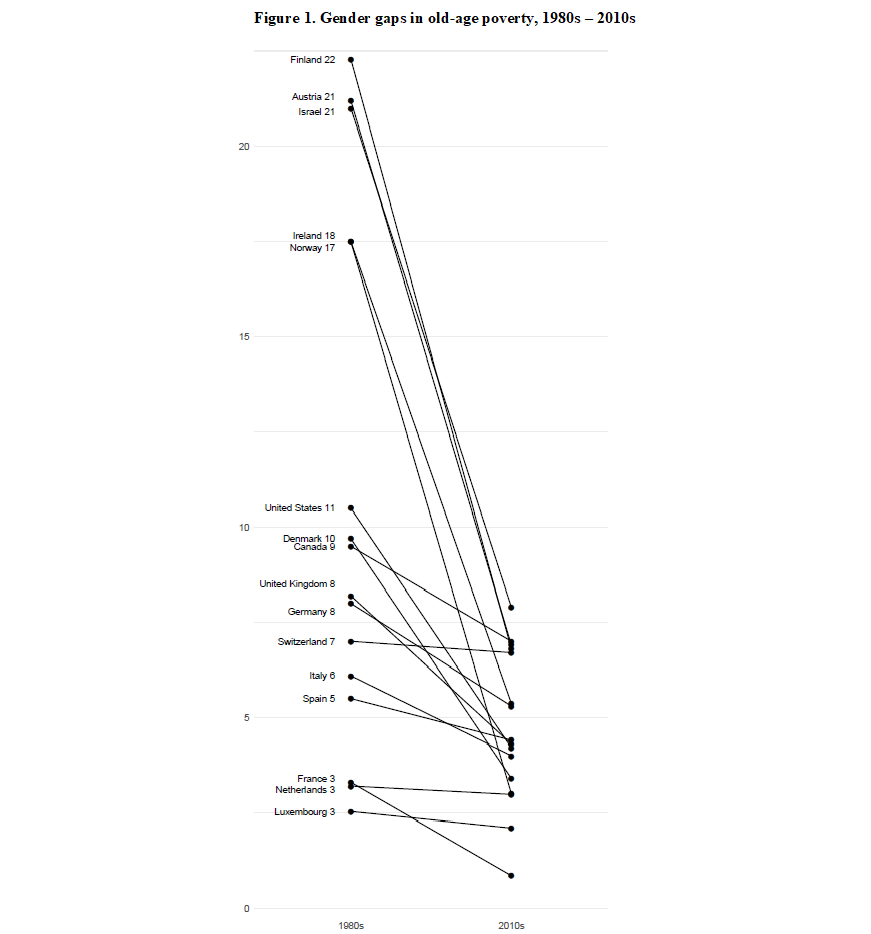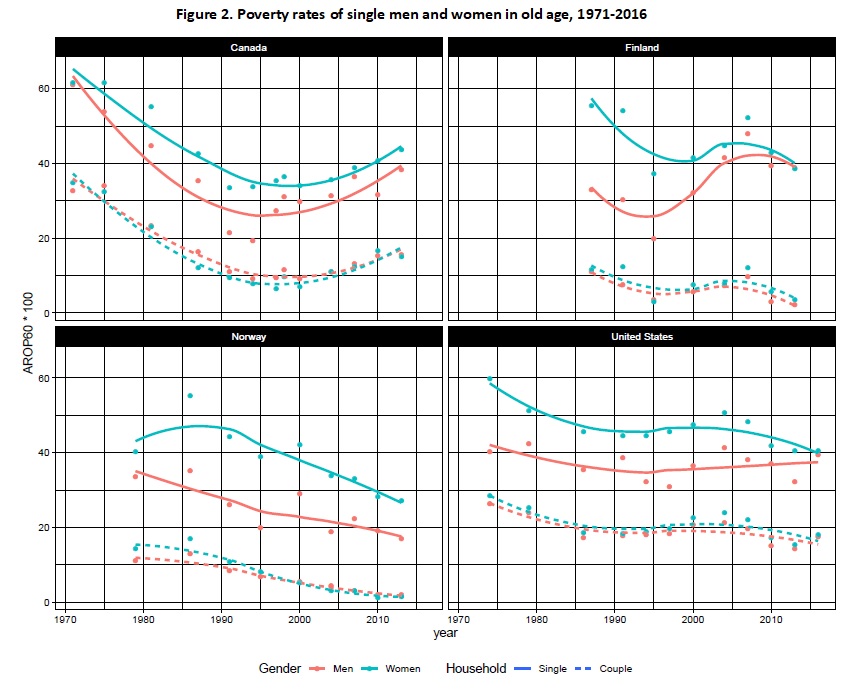Issue, No.11 (September 2019)
Who closes the gender gap in old-age poverty?
This research highlight provides insights into parts of Doctrinal’s ongoing doctoral thesis undertaken at the Swedish Institute for Social Research. A more detailed article on this topic is in preparation
Old age no longer comes with the poverty risks that it used to a few decades ago and with the overall decrease in old-age poverty, concerns about economic inequalities and poverty have shifted to younger age groups (Fritzell and Ritakallio 2010). Yet, among those in old age, vast differences remain. In particular, older women are exposed to greater poverty risks than men (Ebbinghaus, Nelson, and Nieuwenhuis, 2019). Here, we focus on how this gender gap in old-age poverty has developed in recent decades across a number of OECD countries, a subject so far largely overlooked in the literature. Although different studies have shown that this gender gap remains (Smeeding and Sandström, 2005; Zaidi 2010), little is known about the trends of women’s and men’s respective poverty risks. We propose an analytical approach that highlights several distinct patterns that may drive changes in the gender gap in old-age poverty.
Exploring trends in the gender gap in old-age poverty confronts us with methodological challenges. As commonly used indicators of income poverty are based on household income, these measures assume that all income is shared equally among household members and do not differentiate between the poverty status of different members within the same household. As such, the gender gap in poverty based on such measures will be largely – although not exclusively – shaped by the different poverty risks of single men and single women. Longitudinal studies on old-age poverty usually do not take this aspect into consideration but its importance will be highlighted here. A second challenge in examining the gender gap in poverty over longer periods of time across multiple countries is that such analyses require high-quality data of sufficient sample size that is comparable across countries, as well as available for a longer period of time. The Luxembourg Income Study (LIS) database provides such data.
The following analyses focus on trends in poverty risks of single men and women in their early retirement age (65-74). After presenting general trends in the gender gap in old-age poverty in 16 countries, we focus on four (Canada, Finland, Norway, and the United States) that are indicative of distinct patterns in the data. Using LIS data, At Risk Of Poverty rates (AROP) are calculated at the 60% level and based on the median cash disposable household income. The gender poverty gap is calculated as the subtraction of men’s poverty rates from women’s poverty rates.
Figure 1 shows the evolution of the gender gap in old-age poverty among all households in old age – thus combining singles and couples – in 16 OECD countries from the 1980s to the 2010s. The gender gap in old-age poverty has been decreasing in all countries, although the extent of the decline varies across countries. Particularly large decreases were observed in countries as different as Finland, Austria, and Israel, while there was only a marginal decline in, for instance, the Netherlands, Luxembourg, and Switzerland. It is not our goal to explain the differences between countries here but rather to demonstrate that to do so it is pertinent to examine in particular old-age poverty among single women and single men. This is illustrated in Figure 2.

Source: Luxembourg Income Study (LIS) Database.
The general pattern shown in Figure 2 is that the poverty risks of old-age persons have been declining over the last decades, although again there is great variation across countries. This applies both to single and to elderly persons living with a partner, although the latter tend to have substantially lower poverty risks. As we argued above, the gender gap is predominantly visible among single women and men. There is only a very small gender gap in poverty among the elderly who live with a partner, which is the result of the sharing of resources assumed in the At Risk of Poverty measure. Hence, our findings highlight that to understand the gender gap in At Risk of Poverty (AROP), a focus on single people is pertinent.

Source: Luxembourg Income Study (LIS) Database.
Looking at the gender gap in poverty risks in relation to the respective poverty risks of elderly single men and women shows a few interesting patterns that could not be observed in the overall trends shown in Figure 1. In Finland, the gender gap has closed in part because single women’s old-age poverty declined, but also because poverty increased substantially among single men. A similar pattern was observed in Austria, Germany, Israel, and Luxembourg (not shown). In contrast, old-age poverty in Norway declined both among single women and men, but at a faster pace among women. This figure also shows that the marked decline of the gender gap in Norway was in part due to an outlier for women’s poverty in 1986; nevertheless, the overall interpretation holds even without this outlier. A similar pattern of single women’s poverty rates decreasing faster than men’s was found in France, Ireland, Italy, Luxembourg, the Netherlands, Spain and the United Kingdom (not shown). Finally, in the United States, we also saw a decline in the gender gap in old-age poverty but there it was driven by a decline in single women’s poverty while men’s poverty stayed more or less stable. A final pattern was observed in Canada (as well as in Denmark and Ireland) in which the changes in the gender gap were affected to a substantially lesser degree than the overall changes in poverty rates among single women and single men in old age.
To conclude, these results show that the gender gap in old-age poverty has been declining in the 16 countries analyzed here but to different degrees. The gender gap in old-age poverty was shown to be largely driven by single people. Focusing on singles specifically allowed for the identification of four distinct patterns: (a.) single men’s poverty rates increasing relative to women’s; women’s poverty decreasing along with men’s either (b.) declining at a slower pace; or (c.) remaining stable; or (d.) single women’s and men’s poverty rates following the same development leaving the gender gap relatively unchanged. These distinct patterns suggest that different causal mechanisms are at play. Explanations of the gender gap in old-age poverty should therefore focus on singles and consider determinants of both women’s and men’s poverty in old age separately.
References
| Ebbinghaus, B., Nelson, K. & Nieuwenhuis, R. (2019, forthcoming). Poverty in old age (Chapter 20), In: Greve, B. (Editor). Routledge International Handbook of Poverty. Routledge. |
| Fritzell, J. & Ritakallio, V-M. (2010). Societal Shifts and Changed Patterns of Poverty. International Journal of Social Welfare, 19(1):25-41 |
| Smeeding, Timothy and Susanna Sandström (2005). Poverty and Income Maintenance in Old Age: A Cross-National View of Low Income Older Women. LIS working paper series, 398. |
| Zaidi, Asghar. 2010. Poverty Risks for Older People in EU Countries – An Update. Policy Brief 1/2010. Vienna: European Centre for social welfare policy and research. |
